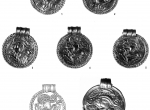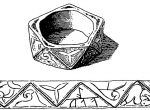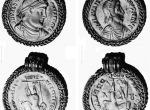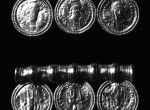Karlino
Karlino, Białogard district, West Pomeranian Voivodeship (Germ. Cörlin/Körlin, Kr. Kolberg-Körlin, Westpreussen), site of discovery in 1838/39, between the K. and Lubiechowo, resting within peat under a large boulder or next to it, at a depth of 30 cm, of a →Migration Period hoard: seven →Scandinavian Bracteat type C (fig. 1) classified to eastern Danish-northern Swedish subgroup of M. Axboe; two looped and framed solidi →Solidus – a Theodosius II (430-440) and a Leo I (462 or 466) struck at Constantinople; gold ornaments: fragment of a bracelet (Kolbenarmring); a gold coiled wire bead; two rings, one of them polygonal, with a runic →Runes/ runic alphabet inscription ALU (fig. 2). Six bracteats →Scandinavian Bracteat (IK 100) were struck with the same die, the seventh (IK 329), struck with a different die, features a runic →Runes/ runic alphabet inscription: WAIGA. Moreover, the same deposit possibly included the following: a gold ring of spirally twisted wire; two looped and framed solidi →Solidus: a Valentinian I (367-375), struck at Trier, and a Valentinian III (ok. 430-445), minted in Constantinople (fig. 3); less likely: a pendant of three solidi →Solidus of Theodosius II fitted with solid tube-like suspension loops (fig. 4), two of these coins struck in Constantinople (408-420 and 420-422), the third at Thessaloniki (424-455). The hoard from K., datable to the early 6th century and presumably brought into the region from south-western Scandinavia, most likely, Funen or Bornholm, is one of the latest finds associated with the Germanic horizon in Pomerania; it suggests contacts between Ostrogothic Italy and Scandinavia. Until World War II most of the finds from K. were held by Museum für Vor-und Frühgeschichte in Berlin, at present they are in the Pushkin State Museum of Fine Arts in Moscow. Analogies on territory of Poland: →Suchań , →Wapno , →Zagorzyn . Scandinavian analogies include Rynkebygård, Elsehoved and Broholm (all three deposits from Funen).
AB
Literature: R. Tybulewicz, A hoard from the Migration Period from Karlino (north-western Poland), Wiadomości Archeologiczne LXII, 2011, p. 143-159; R. Tybulewicz, Skarb z Karlina w świetle archiwaliów: historia odkrycia i losy zabytków, Światowit VII (2006-2008), Fasc. B, 2012, p 165-192.
-
 full resolution
full resolution
Fig. 1. Scandinavian bracteats from Karlino (Tybulewicz 2011, p. 146, fig. 4)
-
 full resolution
full resolution
Fig. 2. Gold polygonal ring with a runic inscription from Karlino, F. Magnusen (Tybulewicz 2011, p. 147, fig. 6)
-
 full resolution
full resolution
Fig. 3. Valentinian I and Valentinian III solidi with loops and ornamental frames, presumably from Karlino, E. Petersen (Tybulewicz 2011, p. 151, fig. 8)
-
 full resolution
full resolution
Fig. 4. Fragment of a gold pendant with three solidi of Theodosius II, possibly from Karlino, P. La Baume (Tybulewicz 2011, p. 152, fig. 9).


